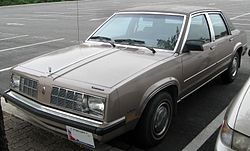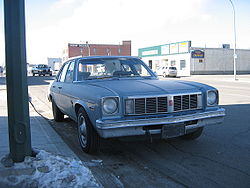- Oldsmobile Omega
-
Oldsmobile Omega 
Manufacturer General Motors Production 1973–1984 Successor Oldsmobile Calais Class Compact Platform X-body The Oldsmobile Omega was a compact car sold from 1973 through 1984 by the Oldsmobile division of General Motors. The name omega was used to imply the last, the end, or the ultimate limit of a set, in contrast to Alpha, the first letter of the Greek alphabet. There were two generations of Omegas, both badge engineered on Chevrolet models, and both using the GM X platform architecture:
- 1973–1979 - rear-wheel drive, related to the Chevrolet Nova.
- 1980–1984 - front-wheel drive, related to the Chevrolet Citation.
1973–1974
First generation Production 1973–1974 Body style 2-door coupe
3-door hatchback
4-door sedanLayout FR layout Wheelbase 111 in (2,819.4 mm) Related Chevrolet Nova
Pontiac Ventura
Buick ApolloThe Omega was one of 2 more X-body Chevrolet Nova clones introduced in 1973 (the Buick Apollo being the other one; the Pontiac Ventura was introduced in 1971). Naturally it shared the Nova's body and many of its mechanicals, but it had its own unique nose and tail, and, being an Oldsmobile, it had a little fancier trim than the Nova. It even borrowed the Nova's dashboard, but Olds added woodgrain trim to it for a more upscale look.
The front grille sported Oldsmobile's trademark split "waterfall" grille design, round headlights set into square recesses, and parking lights directly below in the bumper. Body styles mirrored that of the Nova, starting with a 2-door coupe, 3-door hatchback or a 4-door sedan.
Engine choices were the standard Chevy-built 4.1L (250 cid) I6 with a 3-speed manual transmission standard, with a 4-speed manual or a 2- or 3-speed automatic optional. The lone V8 option was Oldsmobile's 5.7L (350 cid) "Rocket" V8, which had a 4-speed manual as standard with the 3-speed automatic optional. V8 models with the eight VIN digit being the letter "K" received a 4-barrel rochester carburetor. All other V8 engines received the standard 2-barrel version.
Models were base and upper-level Brougham. Not many changes at all in 1974 other than the 2-speed Powerglide transmission being dumped, the parking lights being relocated inboard below the grille instead of the headlights and a new rear bumper design which met the federal government's new 5-mph impact standards. There would be an all-new Omega in 1975.
1975–1979
Second generation 
Production 1975–1979 Body style 2-door coupe
3-door hatchback
4-door sedanLayout FR layout Engine 250 cu in I6
260 cu in V8
350 cu in V8Wheelbase 111 in (2,819.4 mm) Related Chevrolet Nova
Pontiac Ventura
Buick Apollo
Buick Skylark
Pontiac PhoenixThis car was the top of the X-body line along with Buick's Apollo and Skylark, having more luxury trimming, more noise insulation, rear anti-roll bars, and other features not found on the Chevrolet Nova.
During the 1975-76 model years, the top engine choice was a 350 cu. in. (5.7 Liter) V8 from GM's Buick division. During that time, the base engine was the 115 hp (86 kW) 250 cu. in. (4.1 Liter) inline-6 from Chevrolet, until 1977 when it was dropped in favor of the lighter 110 hp (82 kW) Buick 231 V6 . It saw few changes through its life being limited mostly to the front end (3 different grilles) and to the rear lights, changing the number of lenses through the years. The Oldsmobile 260 V8 (4.3 Liter) was available as an option from 1975-79.
1980–1984
Third generation 
Production 1980–1984 Body style 2-door coupe
4-door sedanLayout FF layout Engine 3.8,2.8 L V6
2.5 L I4Related Chevrolet Citation
Buick Skylark
Pontiac PhoenixThe X-bodies were all-new front-wheel drive cars for 1980. Engine choices were now limited to Pontiac's Iron Duke inline-four engine and the new corporate 2.8 L LE2 V6 designed specifically for this platform.
Unlike the Chevrolet Citation, which the car was based upon, the Omega range consisted of 2-door and 4-door notchback sedans, with upright styling and a distinctive split grille.
Aside from the standard and Brougham models produced in all five years, sportier models were also built. These included the SX coupe (replaced by the ES in 1982), ES sedan, and pioneering plastic-fendered SportOmega, which came with wild red-and-orange striping, white-over-gray paint, and a sloping front grille assembly shared with the SX and ES.
Beginning in 1982, the Chevrolet high-output (130 horsepower) 2.8L V6 became available on ES models.
The X-body Omega, like its sister vehicles (the Chevrolet Citation, Pontiac Phoenix and Buick Skylark, proved fairly trouble-prone early on, necessitating an astounding number of government-mandated recalls for braking problems, fluid leaks and suspension issues, just to name a few. While Omega was the only one of the four X-cars to sell better in 1981 than in 1980 (147,918 versus 134,323), starting in 1982, production fell dramatically. Only 77,469 Omegas were built in '82, with 53,926 in 1983 and 52,986 in swan-song 1984.
For 1985, the Omega was replaced by the N-body Calais.
Oldsmobile road car timeline, Post WW2–1970s — next » Type 1940s 1950s 1960s 1970s 6 7 8 9 0 1 2 3 4 5 6 7 8 9 0 1 2 3 4 5 6 7 8 9 0 1 2 3 4 5 6 7 8 9 Subcompact Starfire Compact F-85 Omega Mid-size 66/68 F-85 F-85 Vista Cruiser Vista Cruiser Vista Cruiser Cutlass Cruiser 76/78 Cutlass Cutlass Cutlass Cutlass Full-size 88 88 88 88 88 88 88 88 98 98 98 98 98 98 98 98 98 Custom Cruiser Custom Cruiser Personal luxury Toronado Toronado Toronado « previous — Oldsmobile road car timeline, 1980s–2004 Type 1980s 1990s 2000s 0 1 2 3 4 5 6 7 8 9 0 1 2 3 4 5 6 7 8 9 0 1 2 3 4 Compact Starfire Firenza Omega Cutlass Calais Achieva Alero Mid-size Cutlass Cutlass Ciera Cutlass Cutlass Cruiser Cutlass Cruiser Cutlass Supreme Cutlass Supreme Intrigue Full-size Eighty-Eight Eighty-Eight Eighty-Eight Ninety-Eight Ninety-Eight Ninety-Eight Regency Custom Cruiser Custom Cruiser LSS Aurora Aurora Personal luxury Toronado Toronado Minivan Silhouette Silhouette SUV Bravada Bravada Bravada Categories:- Compact cars
- Front wheel drive vehicles
- Oldsmobile vehicles
- Rear wheel drive vehicles
- Coupes
- Sedans
- Hatchbacks
- 1970s automobiles
- 1980s automobiles
Wikimedia Foundation. 2010.
